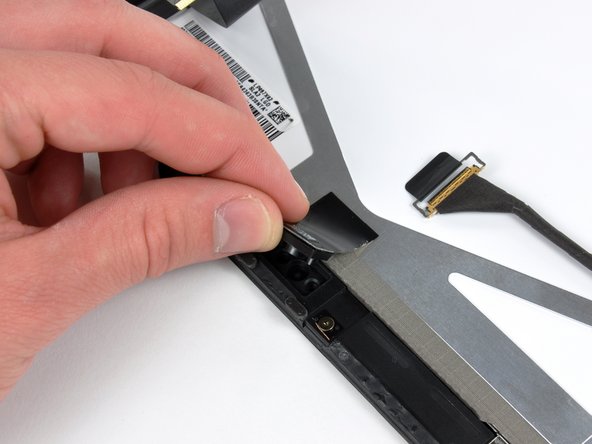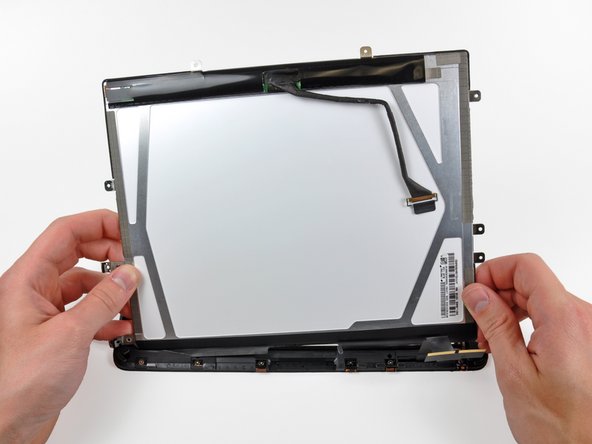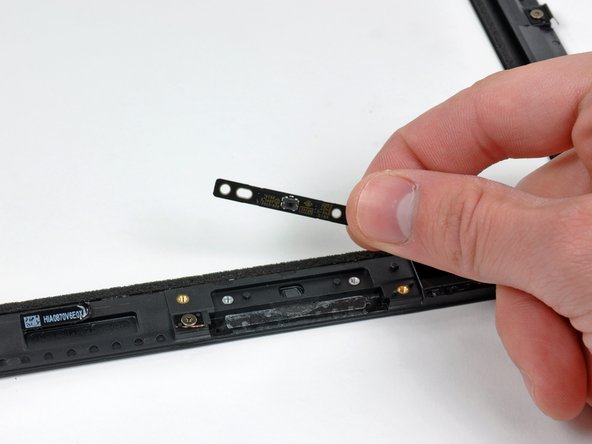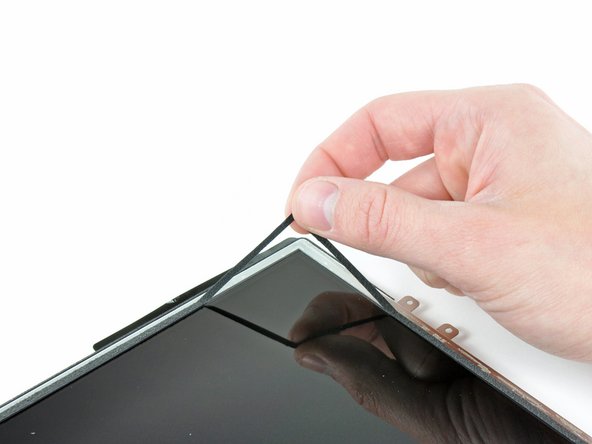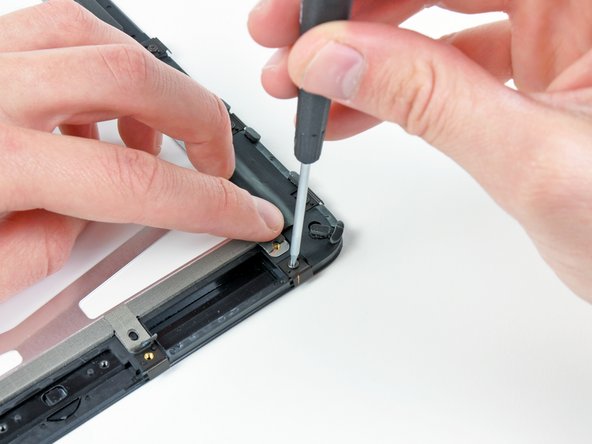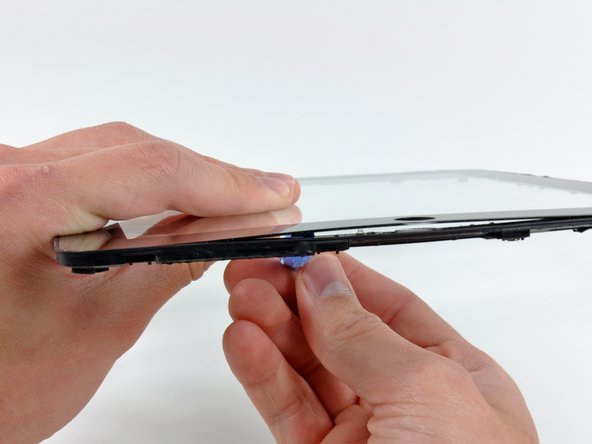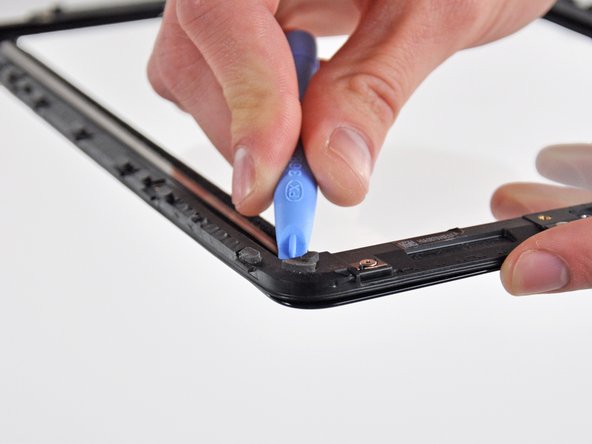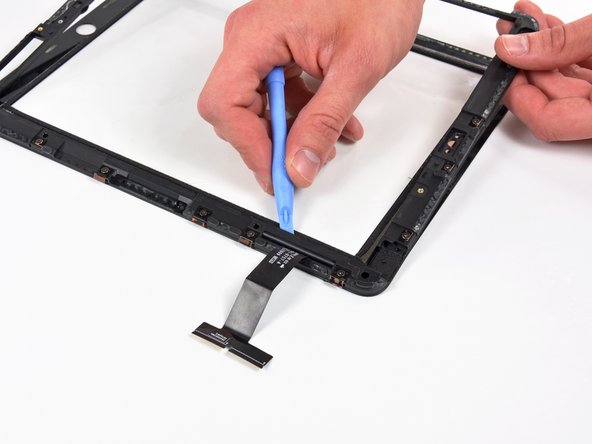Questa versione può contenere modifiche errate. Passa all'ultima istantanea verificata.
Cosa ti serve
-
-
Se il tuo vetro è in pezzi, evita di romperlo ulteriormente e di tagliarti con le schegge coprendolo con del nastro adesivo.
-
Applica delle strisce di nastro adesivo trasparente da pacchi sul vetro, una sopra l'altra, finché è completamente coperto.
-
Fai del tuo meglio per seguire il resto della guida come descritto. Comunque, una volta rotto il vetro, continuerà a rompersi mentre ci lavori e potresti dover usare uno strumento di apertura in metallo per rimuovere il vetro.
-
-
-
Infila uno spudger di metallo tra il bordo superiore del gruppo dello schermo e la scocca.
-
Ruota lo spudger lontano da te per sganciare le clip lungo il bordo superiore dello schermo.
-
Infila un secondo spudger di metallo tra il bordo superiore dello schermo e la scocca per evitare che i ganci si richiudano.
-
-
-
Con uno spudger, procedi lungo il bordo destro dell'iPad.
-
Lo schermo è tenuto fermo dai ganci metallici lungo i bordi superiore, inferiore e sinistro. Il bordo destro ha delle clip in plastica che fanno presa direttamente sulla scocca.
-
Una volta rilasciati i ganci, solleva il bordo sinistro dello schermo e fallo scorrere verso sinistra per liberare i ganci dalla scocca in alluminio.
-
-
Questo passaggio è privo di traduzione. Aiuta a tradurlo
-
Use the edge of a plastic opening tool to carefully pry the ambient light sensor board off the adhesive securing it to the display frame.
-
Once you've gained enough clearance, peel the ambient light sensor off the LCD.
-
-
-
Questo passaggio è privo di traduzione. Aiuta a tradurlo
-
While holding the digitizer cable down, carefully peel back the piece of tape connecting the digitizer cable to the display frame.
-
-
Questo passaggio è privo di traduzione. Aiuta a tradurlo
-
Remove the three T5 Torx screws securing the clips and LCD brackets covered in EMI tape near the home button switch.
-
Carefully peel the display clip and its attached tape off the black plastic display frame.
-
-
Questo passaggio è privo di traduzione. Aiuta a tradurlo
-
Remove the remaining T5 Torx screws securing the LCD to the black plastic display frame.
-
-
Questo passaggio è privo di traduzione. Aiuta a tradurlo
-
Insert the edge of a plastic opening tool under one of the ears attached to the steel LCD frame.
-
Twist the plastic opening tool to gently pry the LCD up off the adhesive securing it to the front glass panel.
-
-
Questo passaggio è privo di traduzione. Aiuta a tradurlo
-
Repeat the process detailed on the previous step to pry up the display around the three sides opposite the digitizer cable side of the display.
-
-
Questo passaggio è privo di traduzione. Aiuta a tradurlo
-
Lift the LCD from its free end, and remove it from the display frame.
-
Carefully peel the adhesive securing the long side of the LCD to the display frame, then remove the LCD.
-
-
Questo passaggio è privo di traduzione. Aiuta a tradurlo
-
If it is still stuck to the front panel, remove the strip of EMI tape near the ambient light sensor socket.
-
-
Questo passaggio è privo di traduzione. Aiuta a tradurlo
-
If they are still in good shape, transfer the clips and EMI tape near the bottom of the LCD to your new LCD.
-
-
Questo passaggio è privo di traduzione. Aiuta a tradurlo
-
Remove the two T5 Torx screws securing the home button switch to the plastic display frame.
-
Remove the home button switch board from the front panel assembly.
-
-
Questo passaggio è privo di traduzione. Aiuta a tradurlo
-
If you are reusing your LCD, use the edge of a plastic opening tool to lift up a corner of the foam tape attached to the LCD.
-
Remove the tape from the perimeter of the glass face of the LCD.
-
-
Questo passaggio è privo di traduzione. Aiuta a tradurlo
-
Remove the piece of yellow tape securing the digitizer cable to the inner face of the front panel assembly, being careful not to rip the cable in the process.
-
Peel the protective sheeting off the inner face of the front panel assembly.
-
-
Questo passaggio è privo di traduzione. Aiuta a tradurlo
-
Stick the tape down along the long edge of the LCD to the frame of the front panel assembly.
-
Carefully lower the LCD down into its recess in the front panel frame, being sure it is properly positioned.
-
-
Questo passaggio è privo di traduzione. Aiuta a tradurlo
-
Hold back the strips of EMI tape along the lower edge of the LCD as you remove the two T5 Torx screws securing the retaining clips shown.
-
Stick the tape down against the new clips and reinstall the two T5 Torx screws.
-
-
Questo passaggio è privo di traduzione. Aiuta a tradurlo
-
Use a heat gun to gently heat the plastic display frame near the home button from the inner side of the front glass panel.
-
-
Questo passaggio è privo di traduzione. Aiuta a tradurlo
-
When the adhesive has been adequately heated, use the edge of a plastic opening tool to gently pry the plastic display frame away from the front glass panel.
-
Run your tool under the plastic display frame to separate it from the front glass near the home button area.
-
-
Questo passaggio è privo di traduzione. Aiuta a tradurlo
-
Heat the lower right corner (as viewed from the front of the iPad) of the plastic display frame to soften the adhesive securing it to the front glass panel.
-
Use your plastic opening tool to continue to pry the plastic frame away from the front glass panel, being careful not to damage the rubber strip around the glass panel's perimeter.
-
-
Questo passaggio è privo di traduzione. Aiuta a tradurlo
-
Continue to heat and pry the plastic display bracket along the lower half of its right edge until it is freed from the front glass panel.
-
-
Questo passaggio è privo di traduzione. Aiuta a tradurlo
-
Lightly heat the rubber connection area. Use a plastic opening tool to separate the plastic display frame from the front glass panel enough to access the rubber area.
-
While holding the display frame away from the front glass, use a razor blade to carefully cut through the many rubber "dots" attaching the frame to the front panel.
-
-
Questo passaggio è privo di traduzione. Aiuta a tradurlo
-
Continue to heat and pry the top edge of the frame until it separates from the glass panel.
-
-
Questo passaggio è privo di traduzione. Aiuta a tradurlo
-
To separate the ribbon cable side of the display bracket, begin by heating near the lower left corner of the panel (as viewed from the front of the iPad).
-
Carefully separate the lower edge of the ribbon cable side of the frame until you reach another area where rubber connects the frame to the glass panel.
-
Repeat the process outlined in previous steps to cut through the rubber "dots" connecting the two pieces.
-
-
Questo passaggio è privo di traduzione. Aiuta a tradurlo
-
Use a heat gun to soften the adhesive next to both sides of the digitizer cable, being careful not to melt the cable.
-
Pry the final section of the plastic display frame away from the front glass.
-
-
Questo passaggio è privo di traduzione. Aiuta a tradurlo
-
Remove the display frame from the front glass, being careful not to rip the digitizer cable in the process.
-
Annulla: non ho completato questa guida.
Altre 36 persone hanno completato questa guida.



















